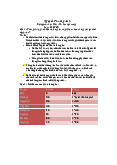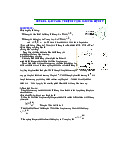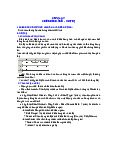















Preview text:
Qual Quant (2017) 51:1305–1320 DOI 10.1007/s11135-016-0332-3
Learning organization at higher education institutions
in the EU: proposal for implementing philosophy
of learning organization—results from research Helena C
ˇ ierna1 • Erika Sujova´1 • Patrycja Ha˛bek2 •
Elena Horska´3 • Zuzana Kapsdorferova´3
Published online: 24 March 2016
Ó Springer Science+Business Media Dordrecht 2016 Abstract
For an organization to develop, to improve, and to innovate in this information
age, it requires a management system that will maximize use of human potential that it has
at its disposal and it develops by establishing a culture of learning and of continuous
progress. The article offers a specific outlook on how to analyze, measure, and evaluate
level of implementation of the learning organization theory as an approach to managing
organizations at higher education institutions in the EU, including Slovakia, versus the
private sector. It includes results from our research, which we conducted between the years
2011 and 2013. To evaluate results of our research, we used adequate mathematical and
statistical methods. Methods of analysis and synthesis as well as a comparison method
were used to interpret results from the research and to form conclusions based on which we
have formulated theoretical and practical contributions. In the article we outlined possi-
bilities for further development of the studied topic; we offer suggestions and recom-
mendations for organizations that aim to implement the learning organization philosophy in practice. Keywords
Learning organization Implementation System Self-evaluation & Erika Sujova ´ erika.sujova@tuzvo.sk 1
Department of Manufacturing Technology and Quality Management, Faculty of Environmental and
Manufacturing Technology, Technical University in Zvolen, Sˇtudentska´ Str. 26, 960 53 Zvolen, Slovak Republic 2
Faculty of Organization and Management, Silesian University of Technology, Str. Roosevelta 42, 41-800 Zabrze, Poland 3
Faculty of Economics and Management, Slovak University of Agriculture in Nitra, Str. Andreja
Hlinku 2, 949 76 Nitra, Slovak Republic 123 1306 H. C ˇ ierna et al. 1 Introduction
We operate in an environment that requires maximum effective use of organizations’
potential (Gellerman 2003). This is necessary to achieve economic and non-economic
results, which every organization aims to achieve. Market share, cash—flow, economic
results, profit and all other financial indicators are secondary results of processes, which
create real value (Hentschel 1992). However, organizations and especially their leaders
forget about this fact. Real success currently stands on people, employees and without any
difference, whether it is a construction employee or a member of upper management. We
live and conduct business in an information society or in a knowledge based or learning
society (Hislop 2005). It is not important how we name this phenomenon, but it is
important how it influences countries’ economies, the global economy and how it influ-
ences success of organizations that operate within a market. Good organizations monitor
new and available information and are able to use it. They can analyze it and through
synthesis can utilize it to benefit their employees (Clarke and Rollo 2001).
All big economic events of our time are based on correct information. Purchase and
sale, production and use of supply and demand are accompanying and necessary factors of
economics, which are fully dependable on human activities, where humans create eco-
nomic value (Hosmer 2003). True competition advantage and any other advantages are
created by information and ability to work with this information and to effectively use it to
benefit the organization (Gregerman 2007). This approach is based on people, without
whom this process would not exist. People are subjects that receive information and are
able to use it for their benefit (Coakes et al. 2002). An individual, an employee, or groups
of employees become real creators of values and of advantages. People are rational beings
and this predestines us to behave with complexity, to have needs and other motivational
factors of our development (Collison and Parcel 2005). Caring for employees, employee
development, and education offer organizations bigger advantages and contributions than
any financial investment into equipment. Innovation, improvement, creativity, new ideas in
corporate culture, and processes currently affect real economy. Therefore, one of the most
important factors in country’s development system, in which a learning organization
operates, is to create opportunities and conditions to support development of its citizens
(Nonaka 2007). This is within the concept of learning organization. People are becoming
the most important capital of organizations and the most important production factor. This
development is also tied to change in management of organizations, from decreasing the
need for hierarchical structure to implementing innovative methods and management tools
for organizations. New management systems that employ employees in management are
entering the market. Despite the fact that information technology is the foundation of quick
and effective realization of information management processes, a learning organization and
the economy are founded on human factors—peoples, i.e. employees. In an organization
with such focus, it will become imperative to utilize knowledge, skills, and experiences of
its employees. The basic factor became education, based on which the need to continuously
further one‘s education is starting to play one of the most important roles in the economy.
A learning organization brings new management concepts, such as knowledge man-
agement and quality management systems. Several management system concepts have
developed since World War II, which were supposed to ensure increase in quality in
management of organizations and consequently to effect quality of final production (Carter
2008). Management systems required change in thinking, an open and innovative approach
of all involved, and constant improvement, while corporate culture played an important 123
Learning organization at higher education institutions in… 1307
influence on organizations’ operations (Antal et al. 2001). Similar concepts are developed
within concepts of knowledge management and learning organization. These result from
increased importance of knowledge in organizations. The above mentioned concepts utilize
human resources for their functioning (Coulson and Thomas 2008). There is a presumption
that their use by no means influences the scope of organizations’ activities, whether it is a
university, a production company or a non-production company. These concepts in
organizations in Slovakia and mainly at higher education institutions, are not fully
researched and audited, even though these have been known for some time. This creates
the basis for our more in depth research (Burg and Mann 2008).
Subjects of our research were universities that operate in Slovakia and in the EU, private
production and non-production organizations, and their management systems. We under-
stand a university as a system comprising of individual parts, individual faculties. We
understand a private organization as any business in production or in services. Our research
focused on organizations’ management systems, on their improvement, which are sup-
ported by quality management systems as well as by organizations’ corporate cultures.
Private sector organizations are not the only ones that can aim to implement the learning
organization philosophy. Therefore, keeping in mind specifics and access to data and
information about universities as well as private businesses, we chose as the object of our
research universities and private businesses operating in Slovakia and abroad.
The subject of our research is the concept of learning organization and its elements,
which are the foundation for self-evaluation of organizations and identification of orga-
nizations’ abilities to continuously improve. If we are considering organizations’ activities
based on quality, it is necessary to point out quality management systems according to ISO
norms. We understand its request for continuous improvement as the basis for imple-
menting the learning organization philosophy. The learning organization philosophy is
understood as addition to an already existing quality management system, as a form of
higher management of organizations. Corporate culture considerably influences the
learning organization philosophy because relationships within an organization, ability to
understand, to work as part of a team, and many other facts of corporate culture are
limiting or supporting elements of implementation of the learning organization philosophy
depending on flexibility of relationships within an organization (C ˇ ierna 2008).
The aim of this research, which we conducted between 2011 and 2013, was to bring
qualitatively higher level of knowledge of the subject of learning organization with focus
on its European dimension and development trends of knowledge economy. Our research
focused on monitoring conditions and principles of existence of learning organization with
priority to define current questions in the context of knowledge economics in the European Union.
The article analyzes approaches of research organizations, possible improvement, trends
of further development within the scope of learning organization. It analyzes all aspects
and algorithms of steps taken by an organization, which stem from opportunities and
threats, with emphasis on using strong and eliminating weak aspects of organizations. 2 Review of literature
Learning organization is currently understood as one of the highest achievements an
organization can achieve in managing its processes to maximize effective use of its
employees’ potential (De Tienne et al. 2004). To reap benefits and take advantages from a 123 1308 H. C ˇ ierna et al.
learning organization is not simple. It is quite difficult to manage an organization, which
aims to achieve the title of learning organization. An organization needs to manage all of
its activities while trying to utilize its previous experiences and also to learn from them. In
Slovak organizations, it is necessary to establish conditions for change in management
towards development of learning opportunities for employees despite the fact that
employee education is part of common management of organizations. In academia, we rely
mainly on opinions of two authors: Peter Senge and Ivana Ticha ´, who directly work with
the term learning organization. We consider Peter Senge’s opinions as fundamental,
because he was the first person to describe it, to identify the term learning organization, and
as the only person to establish criteria that are the basis and scope of the philosophy that he described (Senge 2007).
The term learning organization in literature and in practice is first seen around year
1990, mainly due to P. M. Senge’s input, whose work is cited practically by all specialists.
It is necessary to mention his most famous work published in Czech in 2007 in Prague The
Fifth Discipline: The Art and Practice of The Learning Organization. A quote from a
definition of learning organization is: ‘‘There are organizations, in which people contin-
uously expand their ability to achieve required goals by learning and thereby are con-
tributing to creation and improvement of reality’’ (C
ˇ ierna et al. 2015). There are also other
definitions, such as Pedler et al. (1997), which states that learning organization is a possible
and attainable vision, which due to permanent support for learning by all employees leads
to constant transformation of the actual organization. Watkins and Marsick in their online
contribution to Wikipedia (2015) are of the opinion that it is an organization where all
employees are fully involved in interactive and responsible cooperation and this leads to
sharing of values and principles (Cˇierna et al. 2015).
Peter Senge (2007) views the basis for change in organizations’ management as refusal
of an illusion that the world is made of individual powers, which do not have any rela-
tionship. When we use this illusion, we can then create ‘‘learning organization’’, organi-
zations, in which people constantly improve their skills to attain results, which they truly
wish, where time and attention are given to new and innovative thinking, and where people
learn how to learn together. It has not been true for a long time that one person should learn
for the entire organization, whether their name is Ford, Sloan, Watson or Gates. Organi-
zations that wish to truly stand out in the future will be those who realize how to, for their
benefit, utilize focused attention of people on all levels of organization and their ability to learn (Senge 2007).
Learning organization was interpreted in different ways in the last few years and there
are many definitions. Majority of authors agrees that specific quality of organization
supports learning from one’s experience and from others’ experiences, while this learning
is not understood as education, but as continuous search for better solutions (Asif and
Roauf 2014). As indicated by Nonaka (2001), in Hirocem, a.s., a corporation, they defined
learning organization as an ‘‘organization whose members can gradually analyze what
needs to be done to improve the overall situation, to solve problems related to their work,
and to find solutions‘‘. Essentially, all approaches agree that for the given types of orga-
nization it is true that (1) learning is the most important component, and (2) leadership
perceives the learning process as assistance to individuals and organizations (Nonaka 2001).
Antal et al. (2001) in his article states that experts understand under the term learning
organization quality of work life in which learning becomes the most important factor as
well as implementation of the leadership principle or the principle of couching, which is
based on helping individuals to reach organizational goals. They understand it as a 123
Learning organization at higher education institutions in… 1309
grouping of individuals, in which individuals or groups increase their goal achieving
capacity for goals that they aim to achieve. An author, Kokavcova´ (2009), writes that
learning is not only a question of survival and of success, but it also contributes to
enriching all interested parties who have a relationship with the organization. According to
Webber (2001), despite the fact that there are many definitions of learning organization,
each organization can form its own definition, which will best relate to the organization’s
conditions. When defining a learning organization, we encounter an interesting situation.
Authors who work with the term do not define a learning organization differently.
A difference becomes apparent when some authors have a different understanding of
learning organization in relation to knowledge management and to management of
knowledge itself, while others understand it as a philosophy, which knowledge only uti-
lizes and it is based on a philosophical basis and people’s ability to think. When monitoring
opinions about learning organization, the problem is not that all authors understand the
importance of work with data, information, knowledge, experience and about learning
itself. The difference between individual authors can be seen where learning organization
is seen as a concept in relation to other concepts, especially when comparing knowledge
management (Hamel and Green 2008). According to Paine (2003), there are two distinct
approaches to knowledge management: (1) organizational learning, and (2) learning
organization. While organizational learning is understood as an approach to learning in an
organization created by the environment and by management’s support of learning, with
learning organization, learning is understood as creating a management system, which
understands learning as one unit and it supports it. It perceives learning organization as part of knowledge management.
Petrˇı´kova´ et al. (2010) in her publication Modern Knowledge Management indicates
learning organization as a predecessor and a lower level of management of organization, to
which is tied knowledge management. Mina´rova´ (2009) in her publication Learning
Organization as a Basic Framework of Application of Knowledge Management, in which
she outlined individual concepts separately, including their differences, supports to the
above mentioned authors’ opinions. However, Kokavcova´ (2009) presents models of
transformation of knowledge of learning organization, where she indicates that knowledge
management is on the contrary part of learning organization. Senge (2007) also does not
consider learning organization in terms of innovative activities of an organization to be a
predecessor to knowledge management.
We are siding with authors who define and consider learning organization as the current
highest level in terms of knowledge organization. We are aware of differences between
knowledge management and learning organization (Ha˛bek and Wolniak 2015).
Peter Senge (2003) defined as a first person five disciplines of learning organization. We
can understand these as necessary steps, processes or factors through which it is possible to
implement philosophy of learning organization. These are: systems thinking, personal
mastery, mental models, shared vision, and team learning. Senge considers systems
thinking as the most important factor. He called it the fifth discipline, based on which he
also called his book about learning organization (Senge 2007).
We have outlined theoretical approaches to learning organization, in which we focus on
the soft side of work with knowledge. Another approach to learning offers knowledge
management, which characterizes use of knowledge in a different way to Peter Senge’s
approach. The English term Knowledge Management is translated differently in academic
literature, as knowledge management, management as knowledge, knowledge management
or information management (Petrˇı´kova´ and Kolektı´v 2010). 123 1310 H. C ˇ ierna et al.
3 Research methodology and research results
The following part of the article is dedicated to evaluation of gathered data and information
based on proposed research methodology. Data is presented in graphs and in tables, which
allow for clear and concise presentation of determined results.
The primary source of the research is sociological research where we used a ques-
tionnaire methodology in the form of a structured questionnaire (Onwuegbuzie and Leech
2005; Gau 2013; Ha˛bek 2014). In light of the object and the subject of our research, we
chose investigative methodology to find out the level of knowledge of disciplines of
learning organization and management systems used by an organization and of basic
demographic data. We focused our research on Slovak and foreign higher education
institutions in the EU and for comparison we also used selected private corporations.
Basic collection of statistical data of the research in Slovakia represents all public,
private and government organizations, universities, specifically their individual organiza-
tional parts, such as faculties and departments, selected foreign universities and private
organizations. We have conducted research on a sample of 545 respondents. It comprised
of 134 Slovak higher education institutions, 111 foreign higher education institutions and
300 Slovak private corporations. Selection of respondents corresponded with the focus of
our research where the most important sample group consisted of higher education insti-
tutions, which were the basis of the research. These were complemented by a sample of
private corporations, which we have selected with the goal to compare research results.
One assumption, which we determined before we conducted the research, was that ful-
fillment of disciplines of learning organization does not depend on the type of organization,
but it dependents mainly on the approach and management systems of an organization.
Another assumption was also the fact, that the concept of learning organization, if it is
implemented in an organization, fully conforms to individual demands and to the real state
of a specific organization and is only a concept—a philosophy, which amends approaches
and systems of organization’s management.
Based on these assumptions we express hypothesis H1: H1
There is no difference between implementing the concept of learning organization at
higher education institutions and private corporations, despite the fact that there are fun-
damental differences in functioning and management of different types of organizations.
Respondents of our research were members of upper management of various organi-
zations, which means in terms of faculties, these were deans, in private corporations these
were directors and presidents. Our aim was to get answers from members of upper man-
agement who actively participate in management of an organization and its organizational
structure. The questionnaires were distributed electronically via email, sent directly to
email addresses of selected respondents accompanied by a cover letter. Primary research
was conducted in form of an electronic questionnaire.
From all respondents approached via email (545 respondents) 272 respondents filled out
the questionnaire, which represents 50.09 % of returned questionnaires. In individual
categories, we received 65.67 % of filled out and returned questionnaires from Slovak
universities, 32.43 % from foreign universities, and 45.33 % from private corporations.
The questionnaire and the cover letter were prepared in Slovak and in English. The
research portion consisted of six parts—five parts of learning organization and manage-
ment system of organization and it was divided a follows: systems thinking; personal
mastery; shared vision; mental systems; quality management systems. The final part aimed 123
Learning organization at higher education institutions in… 1311
to find out the sex and age of respondents, how long they have been working at the
organization, place of work, type of organization and type of activities of the organization.
These questions served for better differentiation of respondents and allocation within
individual groups. In the questionnaire we used multiple choice questions, yes and no
questions, ‘I cannot evaluate’ answers, and a five level scale, where one is never, or the
least accurate, and five is always or the most accurately expressing the degree of an answer.
Despite the fact that demographic data in general does not have any effect on results of a
research, as well as on the evaluation and implementation of the concept of learning
organization, we are outlining some structural data from the sample group. The respondent
structure based on selected demographic data was the following: –
Sex or respondents—40.3 % of women and 59.7 % of men participated in the research; –
Age of respondents—respondents between ages 22 and 70 participated in the research;
respondents of 35 years of age represented 35.16 %, respondents of ages between 36
and 50 represented 26.63 % and respondents of ages between 51 and 70 represented 27.47 %; –
Length of employment with the organization—the biggest group 55.02 % consisted of
those who have been working for an organization up to 10 years. Approximately
a third of employees in an organization has been working there between 11 and 20 year
and a group of employees who have been working for an organization for more than
20 years represented 12.64 % of respondents; –
Division of respondents based on location—highest representation was from the
Bratislava region at 16.48 % and the lowest representation was from the Nitra region at 5.13 %. –
Type of organization—we wanted to receive information from respondents about what
type of organization they work for. Their options were following: public, private or
government organization. Public organizations were represented by 42.9 % of
respondents, private organizations were represented by 44.3 % of respondents and
government organizations were represented by 33.0 % of respondents; –
Number of employees—companies with number of employees ranging from 3 to 8000
employees participated in the research. The biggest share had organizations with
101–500 employees at 34.4 %. While organizations with 50 employees or less
represented 29.2 %, organizations with 51–100 employees represented 18 %, and
organization with more than 500 employees represented 18.4 % in our research; –
Type of activity of organization—respondents in our research were mainly from
universities, primarily with focus on economics at 21.61 %. The second biggest group
was medicine, followed by technical studies and then sales, see Table 1.
4 Evaluation of disciplines of learning organization
During evaluation of demographic data, we focused on evaluation of individual results
pertaining to disciplines of learning organization. We researched how often individual
answers occurred and how often they appeared in the selected total group. Since this data
cannot be observed in average values and in its margins of error, we evaluated only how
often they appeared. In some areas, we only selected some questions, which highlighted
and supported individual elements. 123 1312 H. C ˇ ierna et al.
Table 1 Type of activity of organization Type of activity Number of organizations Percentage (%) Cumulative (%) Environment 2 0.73 0.73 Geology 2 0.73 1.47 Hotel management 2 0.73 2.20 International relations 2 0.73 2.93 Natural sciences 2 0.73 3.66 Telecommunications 3 1.10 4.76 Agriculture 4 1.47 6.23 Textiles 4 1.47 7.69 Other 4 1.47 9.16 Forestry 5 1.83 10.99 Law 5 1.83 12.82 Engineering 7 2.56 15.38 Information technology 8 2.93 18.32 Local government 8 2.93 21.25 Construction 9 3.30 24.54 Services 20 7.33 31.87 Humanities 21 7.69 39.56 Sales 29 10.62 50.18 Technical 33 12.09 62.27 Medicine 44 16.12 78.39 Economics 59 21.61 100.00 Total 273 100.00 4.1 Systems thinking
Systems thinking is a discipline within the scope of learning organization. It represents
requirements of constant evaluation of one’s thinking, monitoring of structures and situ-
ations that take place, and most importantly learning from these structures and relation-
ships. For better evaluation of this area, we asked five questions. We have assigned value to
individual questions based on how they signaled fulfillment of criteria of systems thinking.
We consider it fulfillment of a discipline, if a respondent according to our assumption
responded to at least four questions. Based on results of our research, 39.6 % of asked
organizations fulfill systems thinking. The research revealed how differently the term
organization is perceived. While private organizations perceive it as individual parts with
structures, higher education institutions perceive it as an integrated entity.
For illustration we present the formulation of the first three questions from questionnaire and their evaluation:
Question No. 1: You see your organization as: a) entity, unit; b) set of individual part.
The results of our research further suggest that 60.8 % of evaluated organizations see their
organization as a unit and 39.2 % consider their organization as a collection of parts. The
research also revealed a difference in processing of large volumes of data where higher
education institutions have a slight lead before private corporations. A difference was 123
Learning organization at higher education institutions in… 1313 Table 2 Frequency of using Frequency of using feedback Percentage of evaluation (%) feedback Never 3.67 Almost never 11.72 Sometimes 27.83 Often 32.23 Always 24.55 Total 100.00
perceived also in understanding of problems that arose, where higher education institutions
often see a problem on the outside and private corporations evaluate their own internal
approaches and effects on a situation.
Question No. 2 : How often do you use feedback as a learning tool in your organization?
Table 2 displays results of the research in terms of how frequently feedback is used in organizations. 4.2 Personal mastery
Personal mastery is an element of learning organization that pertains to each individual. To
determine areas of personal mastery, we used fifteen questions. We considered that per-
sonal mastery was fulfilled if a respondent answered at least twelve questions based on
requirements of personal mastery. Results confirmed that criteria of the personal mastery
discipline were fulfilled by 64.10 % of respondents. The results indicated that more than
83.9 % of organizations support learning, while only 67.0 % support participation of all
employees. In the discipline of personal mastery, private and higher education institutions
differ distinctly. With regard to personal mastery, one question targeted internal motivation
of employees, in relation to achieving goals, visions, and the organization’s success. We
found out that 75 % of respondents have internal motivation, while 19 % of respondents do
not have motivation and 6 % did not indicate. Table 3 outlines results from the research,
specifically answers to the following question: ‘‘Do you maintain in your work and in your
personal life creative pressure?’’. 4.3 Shared vision
A shared vision is created by individuals’ personal visions. Its purpose is that all individual
and teams within an organization have a shared goal that they want to achieve. From the
results of our research, we can determine that 84 % of organizations have a set vision.
Where 11 % of respondents said that they did not know that there was a vision in their
organization, 5 % of respondents claim that there is no vision at their organization, and
79.1 % of respondents actually know what this vision is. This vision creates a feeling of
shared interest, of shared identity, and of a shared goal for 64.8 % of respondents. Both
types of organizations have a similar approach and position to their shared visions and to attaining these visions.
For illustration we present the formulation of questionnaire´s questions focused on
Attaining and Vision and its evaluation: 123 1314 H. C ˇ ierna et al. Table 3 Maintaining creative Maintaining creative pressure Percentage of evaluation (%) pressure Never 4 Almost never 8 Sometimes 26 Often 40 Always 22 Total 100 Fig. 1 Attaining a vision
Question No. 26: When you fulfill vision, you are: (Look at possibilities of replies in Fig. 1)
The following graph offers some answers from a shared vision. 4.4 Team learning
Team learning is a discipline, which focuses on and develops individual’s skills within a
team as well as of the entire team. Team learning proved to be a problem area, as shown by
the research, since only 26.7 % of respondents fulfill this discipline. An interesting result
was that respondents are willing to accept an idea in 46.26 %, if they are not persuaded
about the opposite, if they themselves do not agree with the opinion. When responding to a
question aimed at determining team learning, 57.5 % of respondents indicated that there is
team work in their organization, 18.7 % answered that team work does not work in their
organization, and 23.8 % stated that there is team work in their organization, but they
cannot evaluate its effectiveness. Table 4 captures reactions of respondents to a question
whether they can freely express their opinions in their organization. Table 4 Free expression of Free expression of opinions Percentage of evaluation (%) opinions Fully disagree 10.30 Disagree 21.20 Neutral 20.50 Agree 22.70 Fully agree 25.30 Total 100.00 123




